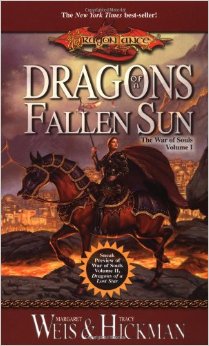 Back in sixth grade, I was riding high off of Fantasy. My dad read me the Hobbit in fourth grade, Lord of the Rings in fifth, and in sixth grade I dove back into both books, trying to get that same fix (Dear gods, have you ever noticed how often I talk about drugs in this blog? It’s like Jay and Silent Bob have a wordpress account and a history of being stuffed into lockers.). Anyway, my tolerance was increasing, so I had to up my dose. And lets face it, Lord of the Rings is great and all…but where are the fucking dragons? Smaug was a fricken badass. Where can I get more of the good stuff? Don’t try to slip me Puff. I need the hard core stuff, man! Well, around that time, my parents shuffled me off one evening to a friend’s house while they went off bowling or something, and I uncovered one of the most dramatic and wonderful discoveries of my life (no, it wasn’t pot). My friend showed me her late father’s (we all miss you, Burt!) library. This guy had stuffed so many sci-fi and fantasy novels into this room that they lowered his heating bill. This full grown adult was a huge nerd, operated an arcade, and read stuff that I thought only existed in, well, fantasy. That’s when I realized that grown-ups didn’t have to be boring, and I could enjoy reading about dragons without feeling like I was wasting a life better spent learning how to manage hedge funds. And fortunately, my friend’s mom let me pick out some books to take home with me. I picked out one with a dramatic pose of Merlin on the cover, as well as the novelization of Star Wars (ghost written by Alan Dean Foster, whom I wrote about in May). But like I said…I needed dragons. And fortunately, Burt had me covered there.
Back in sixth grade, I was riding high off of Fantasy. My dad read me the Hobbit in fourth grade, Lord of the Rings in fifth, and in sixth grade I dove back into both books, trying to get that same fix (Dear gods, have you ever noticed how often I talk about drugs in this blog? It’s like Jay and Silent Bob have a wordpress account and a history of being stuffed into lockers.). Anyway, my tolerance was increasing, so I had to up my dose. And lets face it, Lord of the Rings is great and all…but where are the fucking dragons? Smaug was a fricken badass. Where can I get more of the good stuff? Don’t try to slip me Puff. I need the hard core stuff, man! Well, around that time, my parents shuffled me off one evening to a friend’s house while they went off bowling or something, and I uncovered one of the most dramatic and wonderful discoveries of my life (no, it wasn’t pot). My friend showed me her late father’s (we all miss you, Burt!) library. This guy had stuffed so many sci-fi and fantasy novels into this room that they lowered his heating bill. This full grown adult was a huge nerd, operated an arcade, and read stuff that I thought only existed in, well, fantasy. That’s when I realized that grown-ups didn’t have to be boring, and I could enjoy reading about dragons without feeling like I was wasting a life better spent learning how to manage hedge funds. And fortunately, my friend’s mom let me pick out some books to take home with me. I picked out one with a dramatic pose of Merlin on the cover, as well as the novelization of Star Wars (ghost written by Alan Dean Foster, whom I wrote about in May). But like I said…I needed dragons. And fortunately, Burt had me covered there.
I found a book that not only had a dragon on the cover, but in the title and in the name of the series as well. “Dragons of the Autumn Twilight” looked like a good read, and judging by the more than sixty Dragonlance books now sitting on my bookshelf, I chose wisely. Still, apparently Dragonlance gets as much hate with online critics as it did with…well, anyone who saw me reading one of the books in high school. Yes, I know that vitriolic criticism is kind of a prerequisite for Internet comments, but authors Margaret Weis and Tracy Hickman wrote the Chronicles trilogy, followed by the Legends trilogy, and wound up creating a world people wanted so much more of that TSR published nearly 200 other novels set in the same universe. So what if their prose isn’t up to King James Bible standards? Something about their stories is worth reading (I actually have a more academic analysis of their scenarios and an explanation why Raistlin became the poster child for disenfranchised smart kids who resent pep rallies and wouldn’t get within fifty meters of a football without a marching band around, lest it trigger a fatal asthma attack…but you’d have to take my class to study with me. Contact the admissions office in the Tower of High Sorcery, Palanthas.).
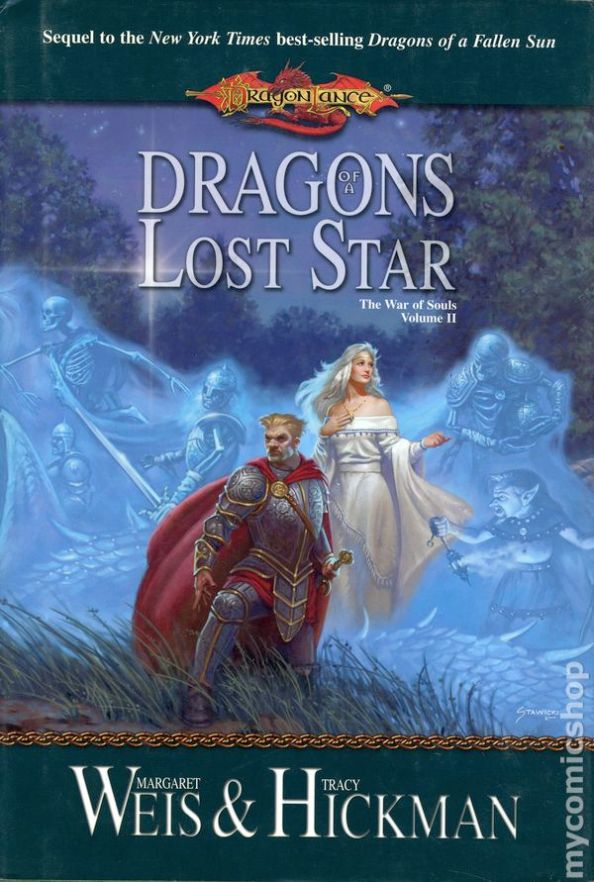 Weis and Hickman are absolute masters at crafting two things: complex, psychologically real characters with an evil alignment, and interesting scenarios. One of my favorite cliffhanger endings of all time is from one of their “Second Generation” novellas, in which Tanis’ son is invited into the Qualinesti nation and offered the crown, only to find out he’s been set up as a puppet king. Forbidden from entering the elven nation himself, Tanis offers parting advice for how to manipulate the political game to fight for control. Another ending comes at the end of Dragons of Summer Flame, in which the gods of Krynn are forced to abandon their creation, and the mortal world has to learn to live without magic, divine influence, or guidance. I finished both of those books thinking, “I want to read that story!” But on account of not being able to write all 200 books themselves, Weis and Hickman had to abandon their creation to authors who treat it with as much respect and sincerity as someone saying, “I promise I won’t get mad,” “I swear I won’t use your credit card to buy porn,” or “I’ll return the Millennium Falcon without a scratch.”
Weis and Hickman are absolute masters at crafting two things: complex, psychologically real characters with an evil alignment, and interesting scenarios. One of my favorite cliffhanger endings of all time is from one of their “Second Generation” novellas, in which Tanis’ son is invited into the Qualinesti nation and offered the crown, only to find out he’s been set up as a puppet king. Forbidden from entering the elven nation himself, Tanis offers parting advice for how to manipulate the political game to fight for control. Another ending comes at the end of Dragons of Summer Flame, in which the gods of Krynn are forced to abandon their creation, and the mortal world has to learn to live without magic, divine influence, or guidance. I finished both of those books thinking, “I want to read that story!” But on account of not being able to write all 200 books themselves, Weis and Hickman had to abandon their creation to authors who treat it with as much respect and sincerity as someone saying, “I promise I won’t get mad,” “I swear I won’t use your credit card to buy porn,” or “I’ll return the Millennium Falcon without a scratch.”
Jean Rabe’s Fifth Age trilogy understood the “no magic” edict about as well as a comatose, double-amputee diabetic understood “no sugar,” and she must interpret the term “psychological realism” to imply that chance encounters with Cthulu are a reasonable and common occurrence. And veteran Dragonlance writer Douglas Niles thought long and hard about “Gilthas becomes a puppet king and learns to manipulate Qualinesti politics to reclaim power,” and decide it was perfect except for the politics…and the idea of a puppet king…and the Qualinesti setting…and Gilthas. So getting to this weeks topic in a roundabout way, Weis and Hickman’s War of Souls trilogy appears to be an attempt at repairing the damage inflicted and lost opportunities squandered by previous authors.
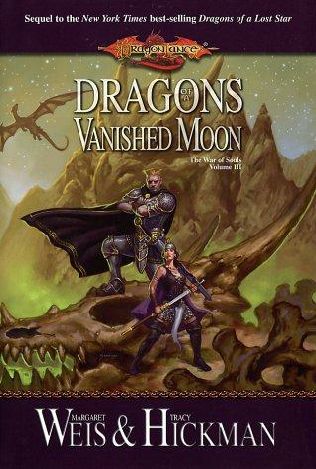 So…the War of Souls begins with Mina, an 18-year-old girl who comes out of storm, prophesying like an Evil Jesus about the One God of Krynn. She makes a few predictions, heals a minotaur’s stump arm, and then proceeds to rise through the ranks of the Dark Knights, waging a stealthy, political conquest of the Silvanesti nation. Meanwhile, Goldmoon wakes up and finds her 18-year-old body restored, while Laurana (who is still about 18 years old in elf years) develops a complex political relationship with the Dark Knight governor of the Qualinesti. And, of course, Tasslehoff makes up for being dead by traveling forward in time, because apparently readers couldn’t possibly grasp the wonders of Krynn unless we see it through the eyes of a child…a child who’s over a hundred years old and has seen absolutely everything that can happen in a world with dozens of sentient races and as many types of magic and unique locales.
So…the War of Souls begins with Mina, an 18-year-old girl who comes out of storm, prophesying like an Evil Jesus about the One God of Krynn. She makes a few predictions, heals a minotaur’s stump arm, and then proceeds to rise through the ranks of the Dark Knights, waging a stealthy, political conquest of the Silvanesti nation. Meanwhile, Goldmoon wakes up and finds her 18-year-old body restored, while Laurana (who is still about 18 years old in elf years) develops a complex political relationship with the Dark Knight governor of the Qualinesti. And, of course, Tasslehoff makes up for being dead by traveling forward in time, because apparently readers couldn’t possibly grasp the wonders of Krynn unless we see it through the eyes of a child…a child who’s over a hundred years old and has seen absolutely everything that can happen in a world with dozens of sentient races and as many types of magic and unique locales.
As expected from a writing skill honed by decades of experience, the War of Souls plot is actually pretty complex and difficult to summarize here. While most of the action in the first two books occurs in the elven nations, there are over a half dozen factions each vying to accomplish their own goals, including the lord of the dark nights trying to stem the rising popularity of Mina, the Krynn dragons who resent their foreign dragon overlords, the dragon overlords who want to destroy each other for more power, Mina who wants to advance the One God’s agenda, Mina’s knights who don’t give a damn about the god and just want to obey the 18-year-old girl’s every command—you know, like Evil Christians—the Qualinesti who struggle with Dark Knight occupation, the Silvanesti who struggle with their isolationist policies, the wizards who just want magic to come back, the Solamnics who just want to crusade against something evil, and Tasslehoff who finds himself a bit unnerved that everyone keeps saying that Chaos was supposed to kill him.
For a series dedicated to the struggle and balance between good and evil, Weis and Hickman successfully avoid all the ethnic cleansing that naturally sprouts up around authors like Tolkien or Brooks. Dragonlance is as much about good and evil as Taco Bell is about fine Mexican cuisine. Character motivation has always been a source of fascination, and the most fascinating thing about the War of Souls is to see which factions ally with each other for what goals, and which characters betray each other like college students calling “shotgun” on the way to the Waffle House; for example, like how Weis and Hickman throw Rabe and Niles under the bus.
If there’s one thing I could say against the book, it’s that it seems to break sequence with proper escalation. Chronicles told us about a war that prevented an evil goddess from entering the world. In Legends, the main character sought to let that goddess into the world so he could fight her, and whichever one emerged victorious, it would still probably trigger at least some amount of apocalypse. By Dragons of a Summer Flame, they ramped up the stakes to find something that would threaten the gods themselves. So when I picked up the War of Souls, I imagined something so epic it would make the finale of Dragonball Z look like an episode of the Smurfs. Instead, they go back to the god-trying-to-enter-the-world plot.Not that it was a bad plot, it’s just that compared to the material that came before, this felt as exciting as Mr. Rogers’ Neighborhood.
And I guess I have to admit, I kind of miss the pacing and adventuring from their earlier novels. You no longer get to explore ancient ruins, lost temples, or travel through time. This is more thoughtful and introspective, and while it’s very good for what it is, it almost feels like the fantastical elements are phoned in. Laurana has her moment in the sun again, which is kind of exciting, but a little less than what the character is capable of. Raistlin makes a cameo appearance, but it feels more like fan service than something that actually drives the plot. But still, I’d recommend it for fans of the series, especially anyone who hated Jean Rabe’s novels and wishes things could just reset back to the way they were before, like a nice, concise cartoon.
Speaking of which…do you think there’s any chance we’ll see “Dragons of a Winter’s Night” after they slaughtered Autumn Twilight with an 80-minute condensation of the novel?
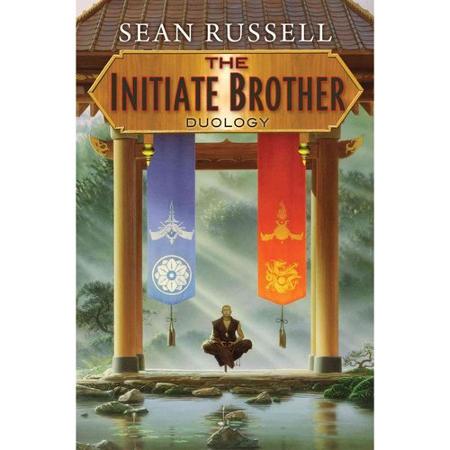 Generally, I only read fantasy as a way to kill time before they can jack me into the Matrix and send me directly into Middle Earth or Krynn or the Star Wars galaxy. Despite that fact, I’m not actually well-versed in modern fantasy novels or authors. It’s pretty rare that my reading list doesn’t resemble a queue of hipsters leading into a Chipotle, so on those rare occasions when I have nothing specific to read, I like to go to Barnes and Noble and pick up random authors I’ve never heard about. This practice makes me realize that for a culture that teaches us not to judge books by their covers, it’s rather irritating that we’ve set up our system of consumer commerce in a way that requires us to literally judge books by their covers. Which is how I ended up with The Initiate Brother Duology, a book about the size of a toaster that contains The Initiate Brother and its sequel, the Gatherer of Clouds. Today I’ll review the Initiate Brother. Or rather, half of the Initiate Brother.
Generally, I only read fantasy as a way to kill time before they can jack me into the Matrix and send me directly into Middle Earth or Krynn or the Star Wars galaxy. Despite that fact, I’m not actually well-versed in modern fantasy novels or authors. It’s pretty rare that my reading list doesn’t resemble a queue of hipsters leading into a Chipotle, so on those rare occasions when I have nothing specific to read, I like to go to Barnes and Noble and pick up random authors I’ve never heard about. This practice makes me realize that for a culture that teaches us not to judge books by their covers, it’s rather irritating that we’ve set up our system of consumer commerce in a way that requires us to literally judge books by their covers. Which is how I ended up with The Initiate Brother Duology, a book about the size of a toaster that contains The Initiate Brother and its sequel, the Gatherer of Clouds. Today I’ll review the Initiate Brother. Or rather, half of the Initiate Brother.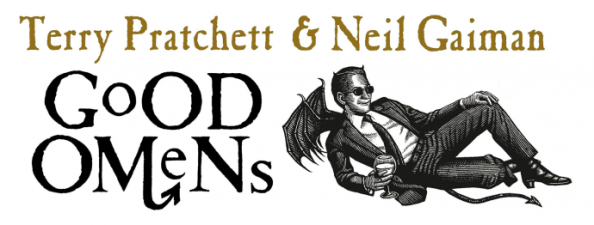
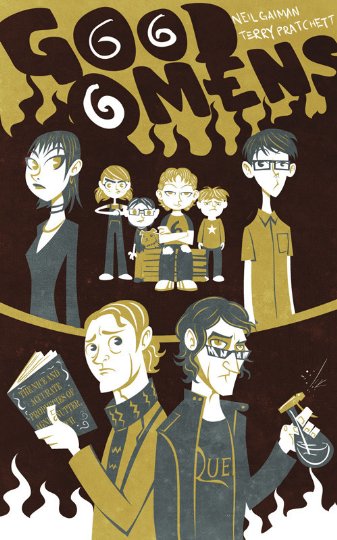
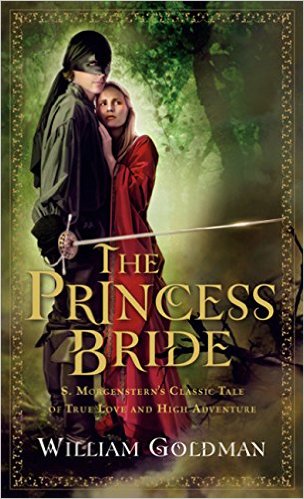 Could there ever be a better tale of winning love, fighting evil, pursuing evil and buckling swashes than The Princess Bride? Yeah, probably. But the movie is still a cult favorite today, and since I don’t want people coming after me with candles and ceremonial daggers and other cultish cutlery, I have to find a tactful way of trashing the book. Much like the Elixir of Life, the Loch Ness Monster, flying cars and universal wifi, mentioning in public that a movie might be better than its book runs the risk of having people cart you off to a hospital and giving you a coat with extra-long sleeves. Nevertheless, I’ve read the entire main story, some of the forwards and special messages, and the first few pages of the “sequel chapter,” Buttercup’s Baby, and I’m so underwhelmed with the story that I stopped writing in the middle of this sentence because cleaning up a backpack that my cat peed on sounded more interesting.
Could there ever be a better tale of winning love, fighting evil, pursuing evil and buckling swashes than The Princess Bride? Yeah, probably. But the movie is still a cult favorite today, and since I don’t want people coming after me with candles and ceremonial daggers and other cultish cutlery, I have to find a tactful way of trashing the book. Much like the Elixir of Life, the Loch Ness Monster, flying cars and universal wifi, mentioning in public that a movie might be better than its book runs the risk of having people cart you off to a hospital and giving you a coat with extra-long sleeves. Nevertheless, I’ve read the entire main story, some of the forwards and special messages, and the first few pages of the “sequel chapter,” Buttercup’s Baby, and I’m so underwhelmed with the story that I stopped writing in the middle of this sentence because cleaning up a backpack that my cat peed on sounded more interesting.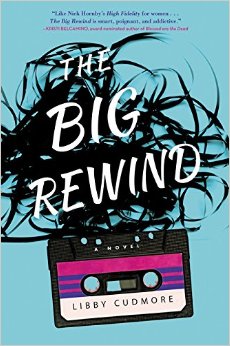 I am beyond thrilled to announce that our own
I am beyond thrilled to announce that our own 

 Back in sixth grade, I was riding high off of Fantasy. My dad read me the Hobbit in fourth grade, Lord of the Rings in fifth, and in sixth grade I dove back into both books, trying to get that same fix (Dear gods, have you ever noticed how often I talk about drugs in this blog? It’s like Jay and Silent Bob have a wordpress account and a history of being stuffed into lockers.). Anyway, my tolerance was increasing, so I had to up my dose. And lets face it, Lord of the Rings is great and all…but where are the fucking dragons? Smaug was a fricken badass. Where can I get more of the good stuff? Don’t try to slip me Puff. I need the hard core stuff, man! Well, around that time, my parents shuffled me off one evening to a friend’s house while they went off bowling or something, and I uncovered one of the most dramatic and wonderful discoveries of my life (no, it wasn’t pot). My friend showed me her late father’s (we all miss you, Burt!) library. This guy had stuffed so many sci-fi and fantasy novels into this room that they lowered his heating bill. This full grown adult was a huge nerd, operated an arcade, and read stuff that I thought only existed in, well, fantasy. That’s when I realized that grown-ups didn’t have to be boring, and I could enjoy reading about dragons without feeling like I was wasting a life better spent learning how to manage hedge funds. And fortunately, my friend’s mom let me pick out some books to take home with me. I picked out one with a dramatic pose of Merlin on the cover, as well as the novelization of Star Wars (ghost written by Alan Dean Foster, whom I wrote about in May). But like I said…I needed dragons. And fortunately, Burt had me covered there.
Back in sixth grade, I was riding high off of Fantasy. My dad read me the Hobbit in fourth grade, Lord of the Rings in fifth, and in sixth grade I dove back into both books, trying to get that same fix (Dear gods, have you ever noticed how often I talk about drugs in this blog? It’s like Jay and Silent Bob have a wordpress account and a history of being stuffed into lockers.). Anyway, my tolerance was increasing, so I had to up my dose. And lets face it, Lord of the Rings is great and all…but where are the fucking dragons? Smaug was a fricken badass. Where can I get more of the good stuff? Don’t try to slip me Puff. I need the hard core stuff, man! Well, around that time, my parents shuffled me off one evening to a friend’s house while they went off bowling or something, and I uncovered one of the most dramatic and wonderful discoveries of my life (no, it wasn’t pot). My friend showed me her late father’s (we all miss you, Burt!) library. This guy had stuffed so many sci-fi and fantasy novels into this room that they lowered his heating bill. This full grown adult was a huge nerd, operated an arcade, and read stuff that I thought only existed in, well, fantasy. That’s when I realized that grown-ups didn’t have to be boring, and I could enjoy reading about dragons without feeling like I was wasting a life better spent learning how to manage hedge funds. And fortunately, my friend’s mom let me pick out some books to take home with me. I picked out one with a dramatic pose of Merlin on the cover, as well as the novelization of Star Wars (ghost written by Alan Dean Foster, whom I wrote about in May). But like I said…I needed dragons. And fortunately, Burt had me covered there. Weis and Hickman are absolute masters at crafting two things: complex, psychologically real characters with an evil alignment, and interesting scenarios. One of my favorite cliffhanger endings of all time is from one of their “Second Generation” novellas, in which Tanis’ son is invited into the Qualinesti nation and offered the crown, only to find out he’s been set up as a puppet king. Forbidden from entering the elven nation himself, Tanis offers parting advice for how to manipulate the political game to fight for control. Another ending comes at the end of Dragons of Summer Flame, in which the gods of Krynn are forced to abandon their creation, and the mortal world has to learn to live without magic, divine influence, or guidance. I finished both of those books thinking, “I want to read that story!” But on account of not being able to write all 200 books themselves, Weis and Hickman had to abandon their creation to authors who treat it with as much respect and sincerity as someone saying, “I promise I won’t get mad,” “I swear I won’t use your credit card to buy porn,” or “I’ll return the Millennium Falcon without a scratch.”
Weis and Hickman are absolute masters at crafting two things: complex, psychologically real characters with an evil alignment, and interesting scenarios. One of my favorite cliffhanger endings of all time is from one of their “Second Generation” novellas, in which Tanis’ son is invited into the Qualinesti nation and offered the crown, only to find out he’s been set up as a puppet king. Forbidden from entering the elven nation himself, Tanis offers parting advice for how to manipulate the political game to fight for control. Another ending comes at the end of Dragons of Summer Flame, in which the gods of Krynn are forced to abandon their creation, and the mortal world has to learn to live without magic, divine influence, or guidance. I finished both of those books thinking, “I want to read that story!” But on account of not being able to write all 200 books themselves, Weis and Hickman had to abandon their creation to authors who treat it with as much respect and sincerity as someone saying, “I promise I won’t get mad,” “I swear I won’t use your credit card to buy porn,” or “I’ll return the Millennium Falcon without a scratch.” So…the War of Souls begins with Mina, an 18-year-old girl who comes out of storm, prophesying like an Evil Jesus about the One God of Krynn. She makes a few predictions, heals a minotaur’s stump arm, and then proceeds to rise through the ranks of the Dark Knights, waging a stealthy, political conquest of the Silvanesti nation. Meanwhile, Goldmoon wakes up and finds her 18-year-old body restored, while Laurana (who is still about 18 years old in elf years) develops a complex political relationship with the Dark Knight governor of the Qualinesti. And, of course, Tasslehoff makes up for being dead by traveling forward in time, because apparently readers couldn’t possibly grasp the wonders of Krynn unless we see it through the eyes of a child…a child who’s over a hundred years old and has seen absolutely everything that can happen in a world with dozens of sentient races and as many types of magic and unique locales.
So…the War of Souls begins with Mina, an 18-year-old girl who comes out of storm, prophesying like an Evil Jesus about the One God of Krynn. She makes a few predictions, heals a minotaur’s stump arm, and then proceeds to rise through the ranks of the Dark Knights, waging a stealthy, political conquest of the Silvanesti nation. Meanwhile, Goldmoon wakes up and finds her 18-year-old body restored, while Laurana (who is still about 18 years old in elf years) develops a complex political relationship with the Dark Knight governor of the Qualinesti. And, of course, Tasslehoff makes up for being dead by traveling forward in time, because apparently readers couldn’t possibly grasp the wonders of Krynn unless we see it through the eyes of a child…a child who’s over a hundred years old and has seen absolutely everything that can happen in a world with dozens of sentient races and as many types of magic and unique locales.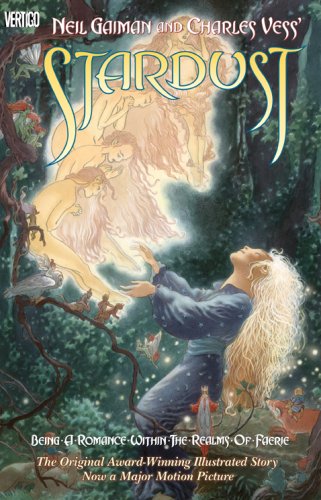
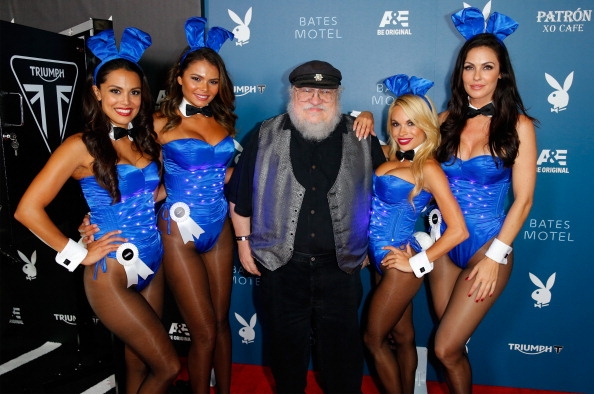
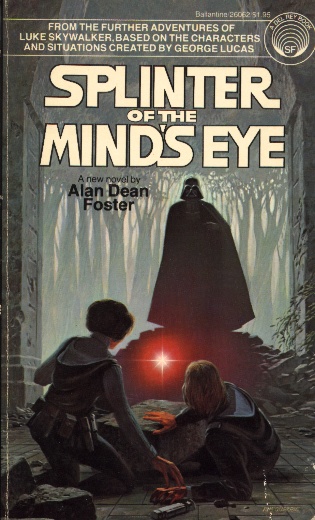 Who would have ever thought that Star Wars would turn out a failure? Trick question! For starters, anyone who’s lived through the prequels. There are few things that generally can enrage people to the point where their blood pressure is higher than that of a decapitated Anime character. One of these things is mentioning the terms “Republican” or “Democrat” in the presence of the opposite. Otherwise, it’s just the Star Wars prequels. So try to understand when I say I love the prequels almost as much as the classic trilogy. I love them from the pointy little tip of Amidala’s crown to the metal hunk of bounty hunter digesting at the bottom of the sarlacc pit. And I tell you this story because I want you to understand the sheer amount of masochism required that when I find out Lucas had planned a low-budget alternative to the Empire Strikes Back in case a New Hope flopped, my first thought was, “I need to read this!”
Who would have ever thought that Star Wars would turn out a failure? Trick question! For starters, anyone who’s lived through the prequels. There are few things that generally can enrage people to the point where their blood pressure is higher than that of a decapitated Anime character. One of these things is mentioning the terms “Republican” or “Democrat” in the presence of the opposite. Otherwise, it’s just the Star Wars prequels. So try to understand when I say I love the prequels almost as much as the classic trilogy. I love them from the pointy little tip of Amidala’s crown to the metal hunk of bounty hunter digesting at the bottom of the sarlacc pit. And I tell you this story because I want you to understand the sheer amount of masochism required that when I find out Lucas had planned a low-budget alternative to the Empire Strikes Back in case a New Hope flopped, my first thought was, “I need to read this!”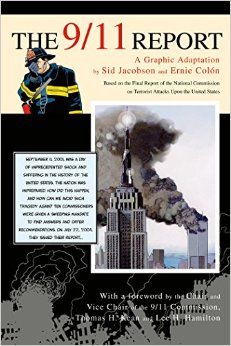 I read a lot of science-fiction and fantasy, but sometimes I wonder if all those epic battles, thrilling worlds and imaginative scenarios might just be a little too exciting. Dangerously thought-provoking. So sometimes, to alleviate all the strain that comes from wonder, creativity and awe, I have to dive right into your plain, old-fashioned recreational reading like a lengthy government document. I tell you, there’s nothing like a tedious analysis of our nation’s security capabilities to make me feel relaxed, settle my blood pressure, and make my brain activity flatline, putting me into that near coma-like trance that tells me there’s no longer any danger of any of those deadly, vicarious thrills that so commonly lay up readers in hospital beds, where they have naught to do but read, thus creating an inescapable cycle. Fortunately, for the time-efficient reader who may not have the time to read through 592 pages of tedious analysis, or for those of us who just want to spice up our recommendations for improved national resistance to terror with a few colorful pictures, I can recommend The 9/11 Report: The Graphic…uh…novel?
I read a lot of science-fiction and fantasy, but sometimes I wonder if all those epic battles, thrilling worlds and imaginative scenarios might just be a little too exciting. Dangerously thought-provoking. So sometimes, to alleviate all the strain that comes from wonder, creativity and awe, I have to dive right into your plain, old-fashioned recreational reading like a lengthy government document. I tell you, there’s nothing like a tedious analysis of our nation’s security capabilities to make me feel relaxed, settle my blood pressure, and make my brain activity flatline, putting me into that near coma-like trance that tells me there’s no longer any danger of any of those deadly, vicarious thrills that so commonly lay up readers in hospital beds, where they have naught to do but read, thus creating an inescapable cycle. Fortunately, for the time-efficient reader who may not have the time to read through 592 pages of tedious analysis, or for those of us who just want to spice up our recommendations for improved national resistance to terror with a few colorful pictures, I can recommend The 9/11 Report: The Graphic…uh…novel?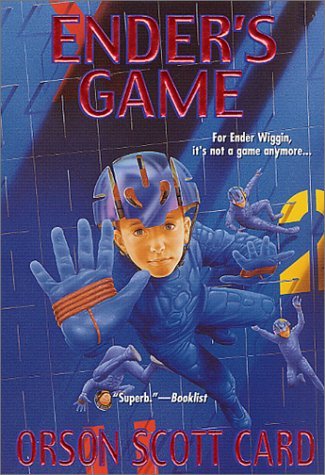
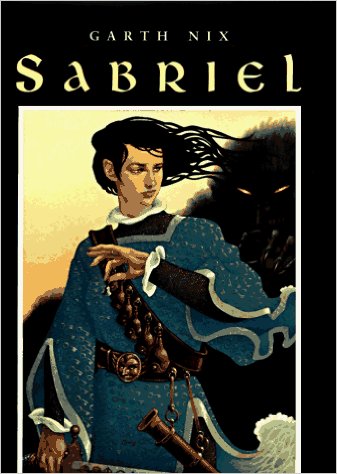 In the past twenty years, the name “Garth Nix” has begun to inspire awe and wonder among Fantasy readers, despite sounding like a Sith Lord who moonlights as a country music singer. Fantasy has, unfortunately, never been known for being an especially progressive genre, what with C.S. Lewis lacing his work with Christian Allegory and Tolkien ethnically cleansing the orcs off the face of Middle-Earth. Kings are good, emperors are bad, and no one has ever innovated a single piece of technology–it’s all just sort of always been there, unchanging, as though crossbows, saddles, and blacksmithing were residue left over from the Big Bang. Most of all, the only people who matter in Fantasy are heroes, powerful, intelligent young men armed only with their father’s sword and the blessings of God who undergo bloody combat to harden themselves in order to face the evil idolatrous sorcerer bent on ruling the world through global slaughter. Sabriel is…not actually any different than that. But the hero is a girl! That ought to count for something.
In the past twenty years, the name “Garth Nix” has begun to inspire awe and wonder among Fantasy readers, despite sounding like a Sith Lord who moonlights as a country music singer. Fantasy has, unfortunately, never been known for being an especially progressive genre, what with C.S. Lewis lacing his work with Christian Allegory and Tolkien ethnically cleansing the orcs off the face of Middle-Earth. Kings are good, emperors are bad, and no one has ever innovated a single piece of technology–it’s all just sort of always been there, unchanging, as though crossbows, saddles, and blacksmithing were residue left over from the Big Bang. Most of all, the only people who matter in Fantasy are heroes, powerful, intelligent young men armed only with their father’s sword and the blessings of God who undergo bloody combat to harden themselves in order to face the evil idolatrous sorcerer bent on ruling the world through global slaughter. Sabriel is…not actually any different than that. But the hero is a girl! That ought to count for something.